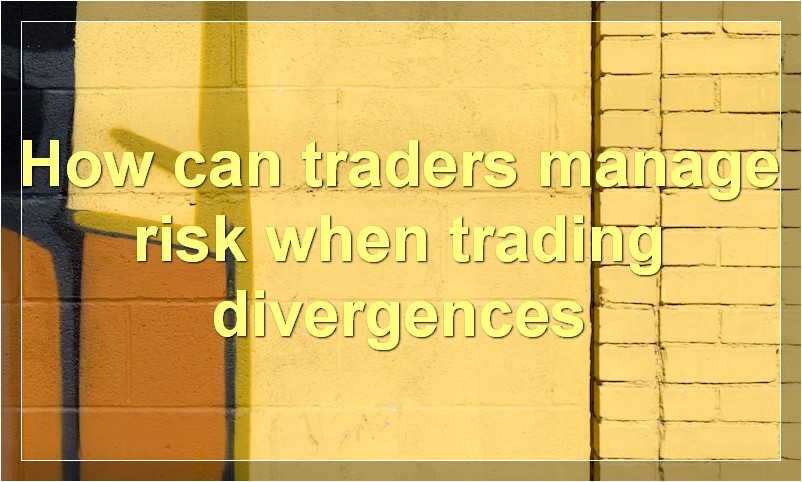If you’re new to the world of trading, divergences may seem like a confusing concept. However, once you understand the basics of how they work, you’ll be able to use them to your advantage.
What is the definition of divergence in trading
In trading, divergence is defined as the difference between the price of an asset and a related indicator. For example, if the price of a stock is rising but the momentum indicator is falling, this would be considered divergence.
Divergence can be used as a leading indicator to predict future price movements. If the price and indicator are diverging, it means that the current trend is losing momentum and a reversal may be imminent. Conversely, if the price and indicator are converging, it means that the current trend is gaining momentum and is likely to continue.
Divergence is just one tool that traders use to make decisions. It should not be used in isolation, but rather in conjunction with other technical indicators and fundamental analysis.
What are the benefits of divergence trading

There are many benefits to divergence trading, including the ability to profit in both up and down markets, the potential to catch big moves, and the increased flexibility it provides traders.
Divergence trading can be a very profitable strategy in both up and down markets. In an up market, traders can buy when the price diverges from the indicator, and in a down market, they can sell when the price diverges from the indicator. This allows traders to take advantage of both directions of the market, which can lead to some big profits.
Another benefit of divergence trading is that it can help traders catch big moves. When the price diverges from the indicator, it often signals a change in direction, which can lead to some large price movements. This can be a great opportunity for traders to make some big profits.
Finally, divergence trading can be a great way to increase flexibility in your trading. By being able to trade in both directions, you can take advantage of more opportunities and potentially make more money. This can be a great way to improve your overall success as a trader.
What are the risks associated with divergence trading
There are a few risks associated with divergence trading. Firstly, if the market you are trading in is not moving in the expected direction, your trades will not be profitable. Secondly, if you do not manage your trade sizes correctly, you could end up losing money. Finally, if you do not have a solid plan or system in place, you may find yourself making bad decisions which can lead to losses.
How can traders identify potential divergences
In order to identify potential divergences, traders can look at various indicators including the MACD, RSI, and Stochastic Oscillator. These indicators can help traders identify when the price of an asset is diverging from its underlying momentum.
What are some common techniques for trading divergences
There are a few different techniques that can be used when trading divergences. One common technique is to look for bullish or bearish divergences on the MACD indicator. Another popular technique is to look for price action divergences on the chart.
When looking for bullish or bearish divergences, you want to look for when the MACD line is making higher highs while the price is making lower highs. This is a bearish divergence and it can be used as a selling opportunity. Alternatively, if the MACD line is making lower lows while the price is making higher lows, this is a bullish divergence and can be used as a buying opportunity.
When looking for price action divergences, you want to look for when the price action is making higher highs or lower lows while the indicators are making lower highs or higher lows. This is a bearish divergence and can be used as a selling opportunity. Alternatively, if the price action is making lower lows while the indicators are making higher lows, this is a bullish divergence and can be used as a buying opportunity.
How can traders manage risk when trading divergences

When it comes to trading divergences, risk management is key. Here are a few things traders can do to manage risk when trading divergences:
1. Use stop losses: A stop loss is an order that you place with your broker to sell a security if it reaches a certain price. This price is usually below the current market price, and it acts as a way to limit your losses in case the security price falls.
2. Use take profit orders: A take profit order is similar to a stop loss, except it’s placed above the current market price. This order is used to lock in profits in case the security price rises.
3. Use limit orders: A limit order is an order to buy or sell a security at a specific price. This can be helpful when trading divergences, as you can set your own prices that you’re willing to buy or sell at.
4. Use trailing stops: A trailing stop is a type of stop loss that automatically adjusts as the security price moves. For example, if you have a trailing stop for a stock at $10, and the stock price rises to $11, your stop loss will automatically adjust to $11. This is helpful because it allows you to stay in a trade even if the security price starts to move against you.
5. Manage your position size: Position size is how many shares of a security you’re buying or selling. When trading divergences, it’s important to manage your position size so that you don’t get too exposed to one security. For example, if you’re buying 100 shares of a stock, and the stock price falls 10%, you’ve lost $10. But if you’re only buying 10 shares of the same stock, and the stock price falls 10%, you’ve only lost $1.
By following these risk management tips, traders can help mitigate some of the risks associated with trading divergences.
What are some common pitfalls associated with divergence trading
There are a few common pitfalls associated with divergence trading:
1) Not paying attention to the overall trend: This is probably the most common mistake made by traders who trade divergences. It’s important to remember that divergences are simply short-term fluctuations within a larger trend. So, if you’re not paying attention to the overall trend, you could get caught in a false divergence and end up losing money.
2) Not using proper stop losses: Another common mistake is not using proper stop losses when trading divergences. Remember, divergences can last for a while, so you need to make sure your stop loss is large enough to protect your profits.
3) Not being patient: A lot of times, traders will see a divergence and immediately enter a trade without waiting for confirmation. This is a recipe for disaster because like we said before, divergences can last for a while. If you enter too early, you could get stopped out before the actual divergence plays out.
4) Trading too many divergences: Some traders think that the more divergences they trade, the more money they’ll make. This is not the case. In fact, trading too many divergences can lead to big losses because you’re essentially increasing your risk without increasing your potential reward.
5) Fading divergences: This is probably the most controversial point on this list. Some traders believe that you should always fade (or go against) divergences. However, this is not always the best idea. Just because there’s a divergence doesn’t mean that price will necessarily reverse. Sometimes, it’s best to just wait for confirmation before entering a trade.
How can traders improve their results when trading divergences
There are a few things traders can do to improve their results when trading divergences. First, they should look for divergences on multiple timeframes. This will help them identify stronger divergences that are more likely to lead to a successful trade. Second, they should use additional indicators to confirm the divergence signal. This could include using an oscillator like the RSI or MACD to help confirm that the price is indeed diverging from the indicator. Finally, traders should pay attention to the location of the divergence. If the divergence is happening near a key support or resistance level, it is more likely to be a significant signal.
What are some advanced strategies for trading divergences
Divergence is a tool that can be used by traders to help identify potential reversals in the market. There are two main types of divergences – bullish and bearish.
Bullish divergences occur when the price of an asset is making new lows, but the underlying momentum is starting to turn higher. This can be seen on a price chart as the price action starts to “hook” to the upside.
Bearish divergences occur when the price of an asset is making new highs, but the underlying momentum is starting to turn lower. This can be seen on a price chart as the price action starts to “hook” to the downside.
Traders can look for divergences as a way to potentially enter into trades in the opposite direction of the recent trend. For example, if you see a bearish divergence on a daily chart, you may want to consider shorting the asset.
There are a few things to keep in mind when trading divergences:
1) Divergences are not always accurate – they are simply a potential warning sign that the trend may be about to reverse.
2) Divergences can occur at any time frame – so make sure you check multiple time frames before entering into a trade.
3) Divergences can last for a long time – so don’t get too anxious if the price doesn’t immediately move in your favor. Be patient and let your trade play out.
What are some expert tips for trading divergences successfully
When it comes to trading divergences, there are a few things that you need to keep in mind in order to be successful. First and foremost, you need to have a clear understanding of what divergences are and how they work. Once you have a firm grasp on that, you need to be able to identify them on your charts. And finally, once you’ve identified a potential divergence trade, you need to know how to enter and exit the trade. Let’s take a closer look at each of these three points.
When it comes to understanding divergences, you need to know that they occur when the price of an asset and a technical indicator move in opposite directions. There are two types of divergences – bullish and bearish. Bullish divergences occur when the price of an asset is making lower lows but the technical indicator is making higher lows. This indicates that the momentum is shifting and there is potential for the price to move higher. Bearish divergences occur when the price of an asset is making higher highs but the technical indicator is making lower highs. This indicates that the momentum is shifting and there is potential for the price to move lower.
In order to trade divergences successfully, you need to be able to identify them on your charts. This can be done by looking for instances where the price and the technical indicator are moving in opposite directions. Once you’ve found a potential divergence trade, you need to know how to enter and exit the trade. When entering a trade, you should look for confirmation from other indicators or chart patterns. And when exiting a trade, you should use a trailing stop loss or take profit targets to lock in your profits.

